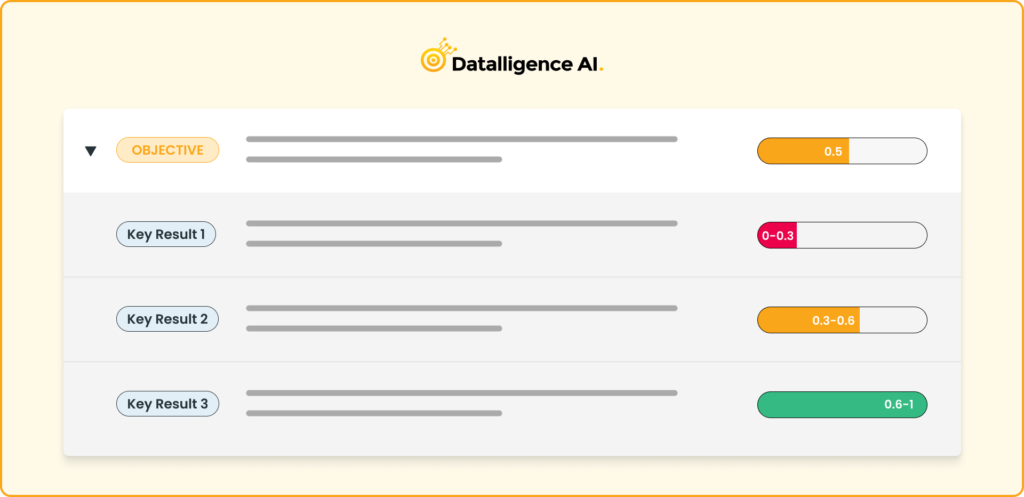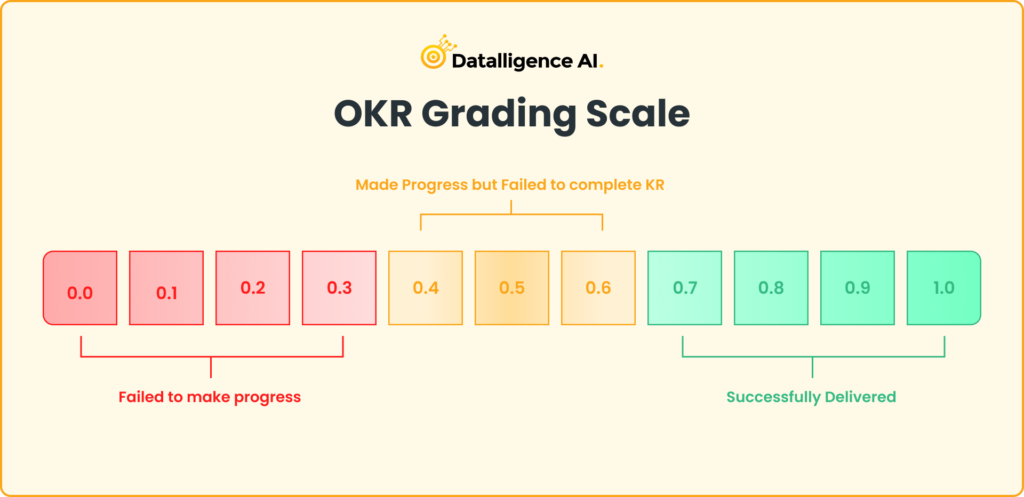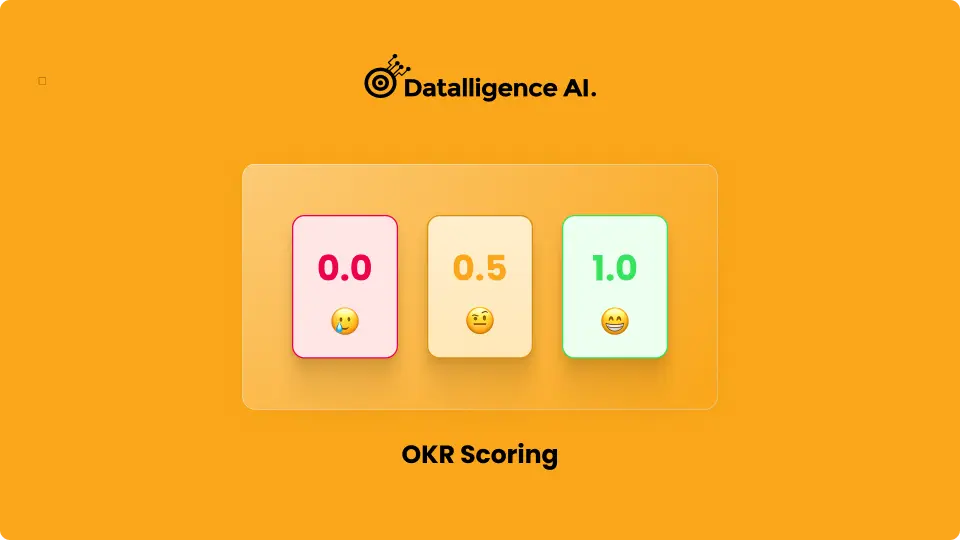“What gets measured gets managed.” – Peter Drucker
This famous quote by management consultant Peter Drucker encapsulates the importance of setting measurable goals and objectives in any organization or personal venture. In today’s fast-paced business world, OKR (Objectives and Key Results) has emerged as a powerful framework to set, measure, and achieve those goals. But how do you measure the success of your OKRs?
In this blog, we will explore the ins and outs of OKR Scoring, how to score OKRs, and how to effectively track progress toward your objectives.
What is OKR Scoring
OKR Scoring is the process by which businesses evaluate the extent to which they’ve achieved their OKRs. It provides a quantitative measure that gives insights into the progress made toward objectives, making it easier for teams and individuals to reflect, adjust, and strategize for future performance.
In its essence, OKR Scoring helps answer two primary questions:
- How well are we progressing towards our objective?
- Did we achieve the key results we set out to accomplish?
When to Score OKRs

Three times during a quarterly OKR cycle is the ideal number of times to grade OKRs. whenever the team conducts its monthly reviews.
Since they plan annually, businesses like LinkedIn and Google might evaluate OKRs less frequently. They might not use OKR scoring in their quarterly retrospectives, in other words.
However, scoring OKRs during your monthly OKR review works best within the OKR cycle for smaller businesses and those who are new to the OKR methodology. Teams can use this time to become accustomed to the procedure, identify what’s working and what isn’t, and make adjustments earlier in the OKR cycle.
How Do You Score OKRs
Scoring OKRs is essential to gauge the progress and understand how closely objectives are being met. The score provides a numerical representation of the performance.
Here’s how you can score OKRs
1. The 0-1.0 Scale
The most common way to score OKRs is on a scale of 0 to 1.0, with 0 indicating no progress and 1.0 signifying that the key result is fully achieved. Anything above 0.7 is typically considered good progress. Alternatively, one can simplify the scale even further by only using colors and emojis.
- 0.7 to 1.0: Green = We delivered.
- 0.4 to 0.6: Yellow = We have made progress, but fell short of completion.
- 0.0 to 0.3: Red = We failed to make any real progress.

Example:
Objective: Increase user engagement on our platform.
Key Result: Achieve a 20% increase in monthly active users.
If by the end of the cycle, you’ve achieved a 14% increase, then: Score = 14/20 = 0.7
2. Percentage Completion
This involves assessing the percentage of completion of the key result.
Example:
Objective: Improve our content strategy.
Key Result: Publish 50 new articles in the quarter.
If 35 articles are published by the end of the cycle: Score = (35/50) x 100 = 70% completion.
3. Binary Scoring
This is a straightforward yes/no or 0/1 system, where the KR is either fully achieved (1) or not achieved (0).
Example:
Objective: Launch the new software version.
Key Result: Release version 2.0 by the end of Q2.
If the version is released by the target date, the score is 1. If not, the score is 0.
4. Graduated Scale
Instead of an all-or-nothing approach, the graduated scale provides some leeway. You’d determine bands of success.
Example:
Objective: Grow our social media presence.
Key Result: Gain 10,000 new Twitter followers.
If followers increase by 10,000 or more, the score = 1.0
Increase by 7,000 – 9,999, score = 0.7
Increase by 4,000 – 6,999, score = 0.4
Increase by 0 – 3,999, score = 0.1
5. Conditional Scoring
Scoring is based on conditions being met.
Example:
Objective: Improve customer support.
Key Result: Reduce ticket response time to under 2 hours and maintain a satisfaction rate of 90%.
If both conditions are met, score = 1.0
If only one condition is met, score = 0.5
If neither condition is met, score = 0
When scoring OKRs, it’s vital to be transparent and honest. The objective isn’t just to achieve high scores, but to genuinely understand progress and areas of improvement. Over time, this reflective process will lead to better alignment and more achievable OKRs.
Google OKR Grading Scale
Google, being one of the pioneers of the OKR methodology, has its own approach when it comes to scoring OKRs. Their method has been widely recognized and imitated by various organizations worldwide.
Here’s an outline of Google’s OKR scoring system:
Google’s OKR Scoring System:
1. 0-1.0 Scale
Google scores its OKRs on a scale of 0 to 1.0.
- 0 means no progress has been made.
- 1.0 means the key result is fully achieved.

2. Interpretation of Scores
- A score of 1.0 does not necessarily mean unmitigated success. Consistently scoring a 1.0 might imply that the set goals were not ambitious enough.
- Scores between 0.6 to 0.7 are considered good. It shows challenging objectives were set, and substantial progress was made towards them.
- Anything below 0.4 can be a cause for concern and may require a discussion to understand the challenges and barriers faced.
3. Ambition Over Achievement
One of the distinctive features of Google’s OKR scoring system is the emphasis on setting challenging and ambitious goals. The philosophy is that aiming high and falling short is still achieving a lot. As a result, consistently achieving a perfect score is discouraged. If teams or individuals consistently score 1.0, it may indicate that their OKRs are not ambitious enough.
Examples of Google OKR Scoring:
Objective: Develop a faster search algorithm.
Key Result: Reduce the average search response time by 20%.
- If by the end of the cycle, the search response time is reduced by 10%, then the score would be: Score = 10/20 = 0.5
- If the response time remains the same, the score is: 0
- If the response time is reduced by the full 20% or even more, the score is 1.0 (although achieving much more than the KR might lead to questions about its initial ambitiousness).
In conclusion, while Google’s OKR scoring system appears simple, the emphasis on ambition and challenging oneself makes it a robust system that fosters innovation, continuous improvement, and high achievement.
Benefits Of OKR Scoring
Scoring OKRs isn’t just about assigning a numerical value to performance. When done correctly, it provides a myriad of benefits that can transform the trajectory of an organization.
Here’s a detailed look into the benefits of OKR scoring:
1. Immediate Visibility: OKR scoring provides a snapshot of progress, enabling everyone to see how they align with organizational goals.
2. Promotes Accountability: Knowing efforts will be quantitatively evaluated makes teams and individuals more responsible and committed to their roles.
3. Constructive Feedback: Regular scoring opens channels for feedback, helping identify areas of growth and improvement.
4. Drives Alignment & Focus: Teams remain in tune with the organization’s objectives, ensuring unified direction and purpose.
5. Encourages Ambition: Emphasizes setting and aiming for challenging goals, leading to greater achievements.
6. Guides Resource Allocation: Helps in identifying areas that need more attention, enabling better resource distribution.
7. Data-Driven Decision Making: Insights from scoring guide strategic decisions and help understand effective strategies.
8. Motivation & Engagement: Meeting or surpassing OKR scores boosts morale and team cohesion.
9. Promotes Continuous Improvement: Regular scoring instills a culture of reflection and iterative progress.
10. Enhances Transparency: Scoring and sharing OKRs openly creates a clear and unified working environment, ensuring everyone knows where they stand.
OKR Grading Scorecard Template
Creating an OKR grading scorecard can help streamline the process of assessing performance and progress toward goals.
Here’s a simple OKR Grading Scorecard Template that organizations can use:
OKR Grading Scorecard
Department/Team: [Department Name]
OKR Cycle: [e.g., Q1 2023]
Review Date: [Date of review]
Objective 1: [Insert Objective Here]

Average Score for Objective 1: [Calculate average of KR scores]
Objective 2: [Insert Objective Here]

Average Score for Objective 2: [Calculate average of KR scores]
Overall Average Score for the Cycle: [Calculate overall average across all KRs]
General Comments/Feedback:
- [Any overarching feedback or observations]
- [Insights into overall team performance or external factors impacting results]
- [Recommendations or action items for the next cycle]
Organizations can modify and expand this template based on their specific needs, the complexity of their OKRs, or any additional data they want to capture. This scorecard serves as a standardized tool for evaluating progress, discussing results, and planning future strategies.
Tips For Scoring OKRs
Scoring OKRs effectively is paramount to ensuring that the system drives both performance and growth within an organization.
Here are some key tips to help you score OKRs more effectively:
- Use a consistent 0-1.0 scoring scale for clarity.
- Maintain transparency in the scoring process.
- High continuous scores hint at less challenging goals.
- Actively engage teams during the scoring phase.
- Treat low scores as growth insights, not failures.
- Separate OKR scores from personal performance reviews.
- Regularly review and adjust targets as needed.
- Document scores for future retrospectives and planning.
- Use scores as a basis for strategic discussions.
- Foster an environment where scores facilitate, not dictate, decisions.
Conclusion
OKR scoring is an integral component of the OKR (Objectives and Key Results) methodology, offering a tangible way to measure progress toward set goals. Properly grading and tracking OKRs can provide insights into performance, highlight areas of improvement, and guide strategic decision-making. It ensures that teams remain aligned with the company’s overarching vision while fostering a culture of transparency, growth, and accountability.
For organizations diving into the OKR world, having a robust system in place for tracking and grading becomes paramount. This is where Datalligence comes into play. Datalligence provides intuitive tools and solutions tailored to streamline the OKR tracking process, ensuring you not only set ambitious goals but effectively measure, analyze, and drive your progress toward them. Whether you’re just starting with OKRs or looking to optimize your existing processes, Datalligence stands ready to elevate your OKR journey to the next level. Talk to our experts and coaches and gain more insights or Try “Datalligence” for “Free”.











